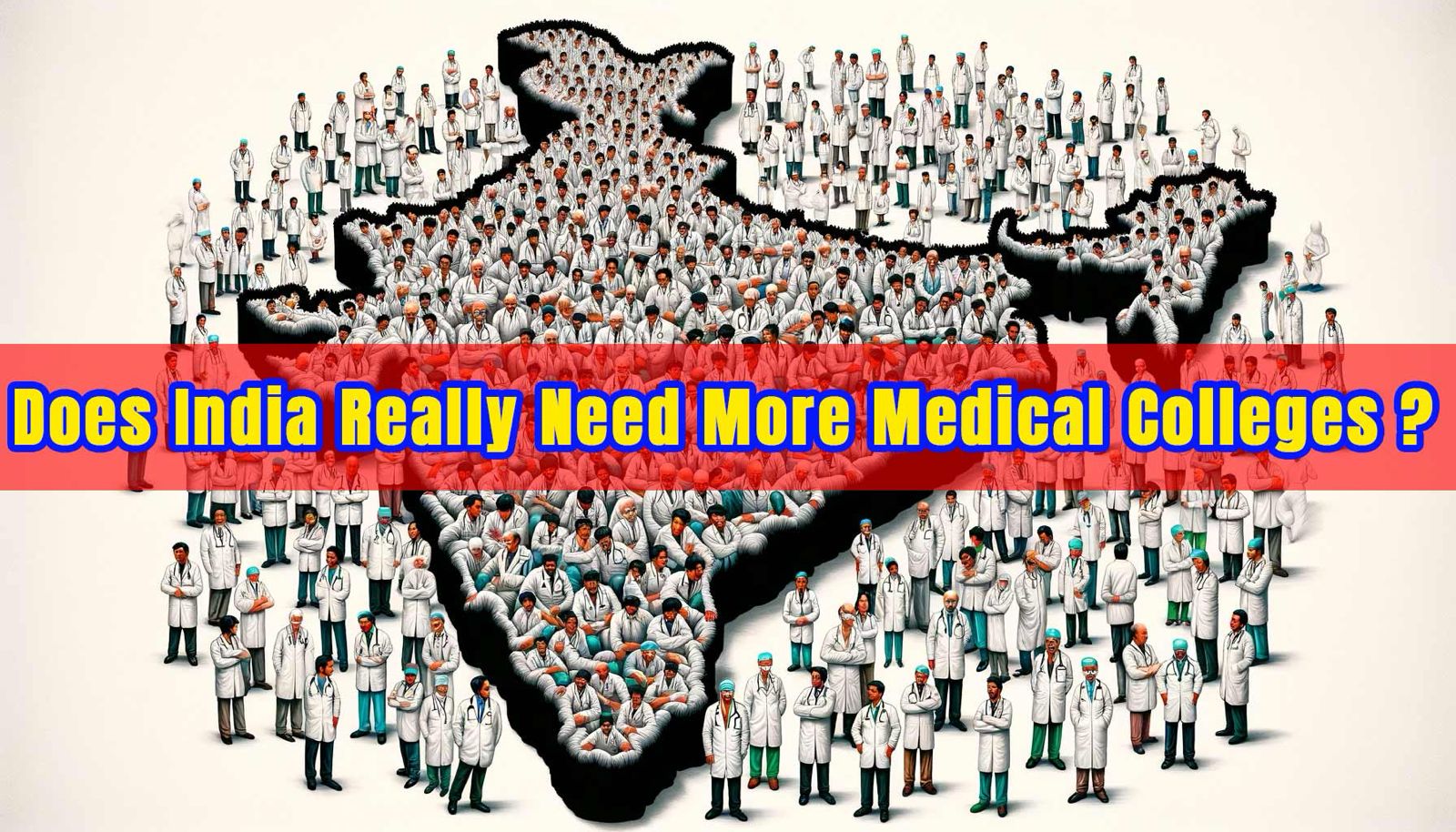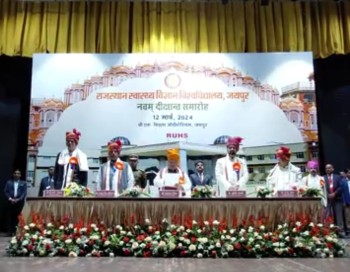Parliamentary panel endorses demand based mushrooming of medical seats, medical fraternity surprised
Department related Parliamentary Standing Committee on Health and Family Welfare has submitted One Hundred Fifty Seventh report on quality of medical education in India. In the report presented to the Chairman, Rajya Sabha on 9th February, 2024 and forwarded to the Speaker, Lok Sabha on same day, it has been mentioned that that there are 702 medical colleges in the country in 2023-24, up by 81% from 387 in 2013-14. Similarly, the number of seats for an undergraduate course (MBBS) increased by almost 110% from 51348 in 2013-14to 1,08,990 in 2023-24, whereas the number of postgraduate seats increased by almost 118% from 31185 to 68073 from 2013-14 to 2023-24.
As per the latest data by the National Testing Agency, 20,87,462 candidates registered for the exam this year, out of which 20,38,596 candidates appeared in the examination and 11,45,976 candidates finally managed to clear the NEET UG examination. As per theNational Board of Examinations (NBE) a total of 2,08,898 candidates appeared for the NEET PG 2023. According to the data furnished by the Ministry of Health and Family Welfare, there are 68073 postgraduate seats in
the country.
The Committee noted that the current situation regarding medical seats both in UG and PG in our country is a critical issue that warrants immediate attention. With an annual influx of approximately 2 million aspiring medical students at UG and only 1/20 times available seats, the demand far exceeds the availability of seats, similarly, the number of available seats at PG level is far less than the demand. The Committee has acknowledged the urgency of addressing this challenge while maintaining the quality of medical education at its highest standard. To address this issue effectively, following measures have been suggested by the parliamentary panel-
01.There is a need to significantly increase medical seats in both undergraduate and postgraduate courses. The government's existing scheme, which focuses on the establishment of new medical colleges attached to district or referral hospitals, can be instrumental in achieving this goal. By expanding this initiative, the Government can create more opportunities for aspiring medical students.
02. To make optimal use of the existing infrastructure it must be ensured that all available resources and facilities are utilized efficiently.It can help accommodate a larger number of students without compromising the quality of education.
03. Streamlining the admission process by implementing a standardized national entrance examination can improve fairness and transparency in seat allocation.
04. Encouraging private investment in medical education is another avenue to explore. Providing incentives and regulatory support to private institutions willing to establish medical colleges can not only increase seat availability but also introduce healthy competition and innovation in medical education.
05. Developing technology for distance learning and organising virtual classrooms that can be a supplementary solution to address the shortage of seats, allowing a more significant number of students to access medical education without overburdening physical infrastructure.
The WHO norms recommend a doctor-population ratio of 1:1000, and as per the NMC, the country has already achieved a ratio of 1:856. However, the concern area associated with opening a new medical college is the number of prescribed department-wise and total patient Bed capacity, read along with the requirement of their 80 per cent average occupancy in the attached hospital. The Committee would recommendthe Government that such one- size-fits-all criterion prescribed in the UG-MSR may be revisited to take into account the geographic imbalances, if any, and formulate region-specific
guidelines/ norms.
Does India need more medical colleges
On the contrary some experts feel that there is no need to open new medical colleges, definitely not the ones that impart substandard education to the affordable, as explained further. Rather, the nation needs to strengthen existing teaching institutes and strive to make them world class. The apex regulator National Medical Council (NMC)s arm Under Graduate Medical Education Board, mandated to guide/licence undergraduate medical education has made some shocking revelation in a report published in 2023. The report says that out of 246 medical colleges accessed in 2022-23, ghost faculty members were found in majority and a lot of these medical institutes don't even have 50 percent of the mandated strength of teaching faculty and senior residents, and, even after giving warnings colleges have failed to improve the shortcomings.
With the current growth rate of population the nation needs around one lakh doctors per year for the next 10 years. And after that, the need for the new doctors will decrease as population growth rate is expected to come down by then.
This shows that India does neither need more medical colleges nor more new medical graduates.
Dr Vivek Gupta, senior pediatrician from Kota, Rajasthan says that, India's death rates & life expectancy are close to developed nations, and this proves that there is no gross insufficiency of medical services in India. Still, when one says that India doesn’t have enough doctors, he probably implies that doctors are overworked, which probably is true, and support to the policy of more medical graduates probably stems from a desire to reduce the burden on doctors & ensure that doctor work optimally. But, it needs to be understood that the achievements in health care sector have come at pennies vis a vis rest of the world because, most doctors are working hard and more for barely decent living, in turn reducing cost per patient and increasing efficiencies per Rupee. Once she/he has to make a living working ‘optimally' i.e, doing less work, the cost will increase exponentially. Further, to keep attracting best talent, every doctor will need to be provided with a decent living commensurate with her/his hard work, study years, education level and qualifications, and not to forget the living for an average of 5 families employed in ancillary professions like nurse, housekeeping, paramedical personnel, pharma industry etc that each Doctor roughly creates on average.
As a nation, is India ready to either pay much more for same work, as in western nations¹ or choke the supply of quality healthcare providers by shooing away the best talents from field of medicine due to policies, or wasting scarce resources on making doctors who may quit profession for not being able to fulfil the expectation of decent living, asks Dr Gupta. "Let's hope that policy makers have calculated this while formulating a policy that emphasizes need of more medical schools" adds Dr Gupta.
Health care philosopher's thoughts for future better healthcare can be summarised as below-
1) Now that India has numbers, it needs to stress upon quality of medical education in medical colleges to match the western standards.
2) It needs to have a policy for proper distribution of doctors in various parts of India, and rather than being punitive it needs to be rewarding for services rendered in far fledged and remote areas.
3) The distribution of doctors in various states and cities can also be helped by making a PAN India registry, and allowing PAN India single registration to practice in India.
4) The need is production of doctors more in GP category, as the specialist number production is probably sufficient now.
5) Medical education should be separated from healthcare, and a medical institute’s budget should be clearly divided in the health care delivery and teaching segment, so that the actual cost of educating a doctor can be estimated, without subsidising healthcare from medical education and thus loot in name of medical education be tamed.² Cross subsidizing healthcare that is state responsibility³ from medical student fees as being done by shrewd accounting today is unacceptable and unsustainable in long run. It artificially increases the cost of medical education, and to justify that a mockery of NEET-UG and NEET-PG has been made. Now, Neet- UG has been reduced to fulfill purpose of auctioning medical education. To hide the number of seats staying vacant due to high fees, 1 million NEET-UG aspirants are declared eligible for 1lakh (100 thousand) odd seats out of 2 millions aspirants. This artificially inflated eligibility allows colleges including government ones to increase fees and still get candidates, but with poor academic performace. Effectively, now anyone with average marks can become a doctor provided s/he has a deep pocket.
It also pushes families into debt trap that increases financial stress on families, forcing young doctors to go unethical or even suicidal in some cases. It appears, that in a bid to sell medical education to the highest bidder, rather than most eligible ones, quality and merit has taken backseat, that doesn’t auger well for any nation. Similarly reducing cutoff to zero percentile in NEET PG makes a candidate with zero or lesser marks eligible for a speciality seat that may fetch college Rs one crore or two. One can only pray that one doesn't have to be treated by such a specialist.
¹ US average health expenses per capita 12940US dollar vs Indian everage of 6700 Rupees (~80$) at notional price and ~275$ at PPP
² Public funded hospitals and medical colleges have a fee structure that can go upto 25 lakh per annum for 4½ years of basic medical graduation, approx 15 times average annual income, and then upto double this sum per year for 3 years of residency/post graduation depending upon speciality in non public funded institutes.
³ Directive principles of state policy, Constitution of India mandate that the Governments must strive to provide healthcare to people of nation. Apex court in verdicts has reiterated that the right to health is essential component of Right to life.






Recent comments
Latest Comments section by users
Guest
Feb 20, 2024
Excellent article describing problem
Guest
Feb 20, 2024
Brilliant analysis .
Guest
May 31, 2024
I would also like to mention the amount of fees charged by deemed college is too much not at all affordable for academically deserving students while reservation seats takes majority of the seats.